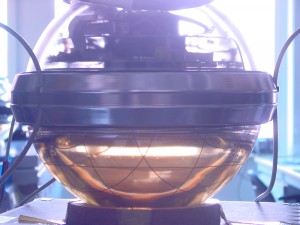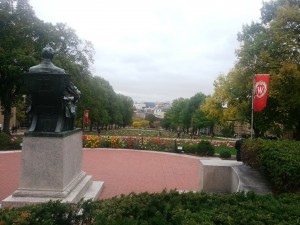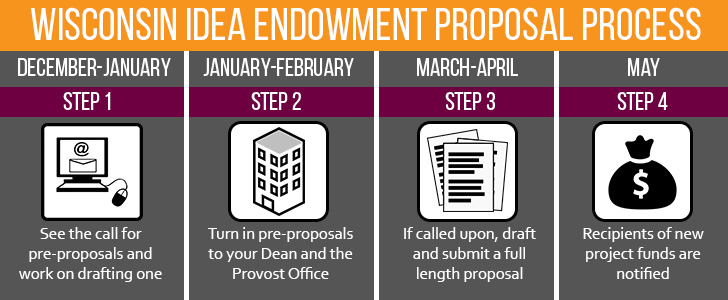by Renee Shields
MADISON, Wis. – When Eden Inoway-Ronnie talks about the Wisconsin Idea, she could go on all day about the intriguing applications and projects that she’s seen.

“One was the IceCube Neutrino Observatory in the South Pole, so Antarctica. What these folks did was develop a film, posters and other things and committed to traveling around the state to two-year college campuses to share information about this huge scientific observatory in the South Pole,” Inoway-Ronnie said.
Inoway-Ronnie is the Chief of Staff in the Office of the Provost at the University of Wisconsin-Madison and is also the Coordinator of the Wisconsin Idea Endowment on the behalf of the Provost’s Office.
The project described above, called Bringing the Universe to Wisconsin, is one of many projects that have been funded by the Wisconsin Idea Endowment. According to Inoway-Ronnie, the endowment funds approximately 8-12 projects each year.
The donors behind the Wisconsin Idea Endowment Funds are Ira and Ineva Reilly Baldwin, a couple whose large gift of $18 million funds projects that embody the Wisconsin Idea.
According the Provost’s Office website, UW-Madison established the Baldwin Endowment in 2002, with the money being one of the largest gifts that the University has ever received. Although the Baldwins have contributed many gifts to the university, this particular gift aims towards giving back to the community.
“The idea is to help educate folks throughout the state about the science that is generated here,” Inoway-Ronnie said about this specific project, “to sort of raise the awareness about new discoveries around the universe and bring high end particle physics information to laypeople throughout the state.”
Although this specific gift is directed toward advancing the Wisconsin Idea, the university receives many different types of gifts from donors who want to give back. Often, these gifts become part of endowment funds, which are used for specific purposes on campus, according to UW Foundation Chief Administrative Officer and Director Of Legal Affairs Scott McKinney.
“Some donors want to get as granulose as possible and support specific research projects within a school or college or within a specific department, or provide scholarship support for students from a particular high school or part of the state or part of the country. So it’s really a donor’s choice as far as how broad or narrow they want that focus to be,” McKinney said.

According to McKinney, donors can specify their gift to be used for anything from discretionary support to the university as a whole to support for a specific school or college.
Once the donor specifies where the funds are to be used and they officially become part of an endowment fund, the UW Foundation is under legal obligation to use the funds in that way, according to McKinney’s colleague David Golden, a UW Foundation Investment Analyst.
This ultimately means that endowment funds cannot be used to fund operations that are outside of a donor’s specifications. However, Golden said that the foundation’s current leaders are trying to explain to donors how important discretionary support to the university as a whole can be moving forward in coming years.
“So we can’t really make any changes from a legal perspective for the dollars we’ve already received, but I would say that going forward, we are continuously happy to receive those dollars. We are trying to educate and make our donors and those that care about the University aware of just how impactful unrestricted gifts can be,” Golden said.
Gifts like the Wisconsin Idea Endowment Funds do not have to follow the exact same process every year though, according to Inoway-Ronnie. The funds must meet the original criteria set by a donor, but can evolve from there.
“This year we’re doing something a little different. We decided that it might be a nice idea for people who are doing smaller projects to have an opportunity at a smaller amount of money,” Inoway-Ronnie said.
Alongside the 8-12 larger funded projects that can request up to $120,000 each, these smaller projects, referred to as “mini-grants,” can request up to $4,000 each. Both categories allow the projects to run from one to three years, according to the endowment’s website.
According to Inoway-Ronnie, the Wisconsin Idea Endowment funded 18 mini-grants for 2015. A selection committee, made up of faculty from various departments across campus, will meet in mid-May to determine how many bigger projects will be funded with this year’s assets.
Projects go through an extensive process when being considered for funding. Just this past year, over 100 pre-proposals were submitted for consideration.

Inoway-Ronnie said that one of the unique parts of the Wisconsin Idea Endowment is that both students and staff can propose projects for funding.
“The e-mail message goes out to everybody on campus, inviting them to submit pre-proposals and they have to get sign off at both the department level and the dean level,” Inoway-Ronnie said. “We want the department chairs and the deans to know what their faculty or students are proposing to make sure it’s in line with the general goals of that school or college.”
According to Inoway-Ronnie, graduate students often collaborate with faculty on their proposals. It is also not unheard of to have an undergraduate submit a proposal.
Of this year’s 18 mini-grant awards, at least four had student involvement. According to the mini-grant funding records, a sophomore undergraduate student was awarded a grant for a Black Music Ensemble project that will take place this fall.
The Wisconsin Idea Endowment is affiliated with the UW Foundation, which is the entity that manages the funds. According to Inoway-Ronnie, the actual endowment fund is never spent, but rather the foundation allows the endowment to grant the appreciated interest each year.
According to Golden, the foundation manages the Wisconsin Idea Endowment and over $2 billion dollars in endowed funds. All endowed funds, although separate from one another, share the same processes in the foundation. These processes include receiving the dollars and appreciated securities, investing them and transferring them to campus.
“Those kind of mechanical things all more or less stay the same. In the end, when establishing an endowed fund, it’s that the current spendable income has immediate impact and then you have that impact forever. Endowed funds will exist for as long as there is a University of Wisconsin-Madison,” Golden said.
So long as there is a university, the foundation will also continue to seek out donors and embody the Wisconsin Idea in their own practices by finding funding for projects that will impact the world.
“So really what is comes down to, is just like the Wisconsin Idea has the goal of extending the influence under the knowledge of the university, we’re going out and seeking around the world stage the individuals who care about the university and want to see its mission, its research, its teaching, the ability to create scholarships and endowments that will be impactful for the entire world once they’re set up here at UW-Madison,” Golden said.
For more on this topic, click here.
